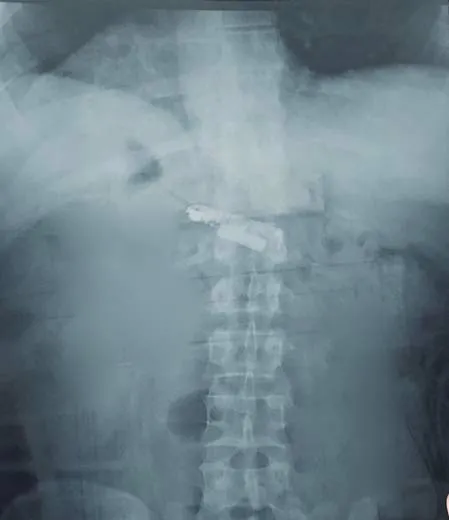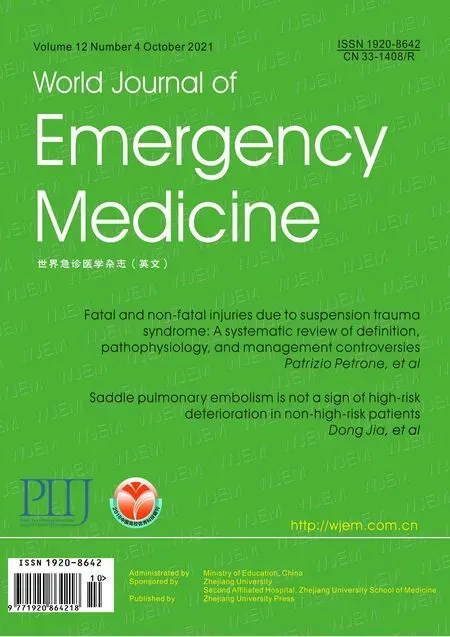The cell phone in the twenty-fi rst century: Risk for addiction or ingestion? Case report and review of the literature
Sanja Dragasevic, Milica Stojkovic Lalosevic, Ljubisa Toncev, Tamara Milovanovic, Aleksandra Pavlovic Markovic, Srdjan Djuranovic, Dragan Popovic
1 Clinic for Gastroenterology and Hepatology, Clinical Center of Serbia, Belgrade 11000, Serbia
2 School of Medicine, University of Belgrade, Belgrade 11000, Serbia
Dear editor,
Foreign body ingestion and food bolus impaction are frequent emergency cases in clinical practice.[1]The majority of foreign body ingestion cases occur in the pediatric population, while individuals with mental illness, neurodevelopmental disorders, alcohol intoxication, and prisoners are recognized as a high-risk adult population for foreign body ingestion.[1,2]The American Society of Gastrointestinal Endoscopy (ASGE) in 2011 and the European Society of Gastrointestinal Endoscopy (ESGE) in 2016 published clinical guidelines which addressed the management of foreign bodies in the upper gastrointestinal tract of the adult population.[3,4]In general, up to 90% of foreign bodies pass spontaneously, 10%-20% require endoscopic removal, while approximately 1% require surgery for extraction or treatment of developed complications.[4]Despite the fact that clinical guidelines for gastric foreign bodies are developed, they are restricted so far to common objects such as small metal objects or narcotic packets.[3,4]We report a very rare case of swallowed mobile phone in a 35-year-old male with a review of the literature.
CASE
A 35-year-old male prisoner was admitted to the emergency department due to stomach pain and vomiting. He had no other associated symptoms including dysphagia, retrosternal pain, hypersalivation, choking, stridor, or dyspnea. The patient reported that he had swallowed a hand watch five hours before the abdominal pain started. The patient didn’t have any illnesses in his previous history. Mandatory physical examination was performed and excluded the presence of small-bowel obstruction, symptoms indicating perforation, presence of wheezing or aspiration. Clinical examination, except high body mass index (BMI, 31 kg/m2), was unremarkable. All laboratory findings were normal, including complete blood count, biochemistry, as well as coagulation parameters and inflammation markers. The radiographic evaluation of the neck, chest, and abdomen identified the presence of a foreign body described as a complex metal object in the stomach, with no progression along the intestine (Figure 1). Upper endoscopy was performed and identified a mobile phone in his stomach, localized in the proximal corpus, without any signs of gastrointestinal bleeding. Thereupon, the patient admitted to having ingested his cell phone, not allowed in the prison ward, one day before. During the following esophagogastroscopy, the object could not be adjusted accordingly, and the endoscopic removal was unsuccessful using endoscopic snares, graspers, tripod forceps, and baskets. Due to the size of the mobile phone, the use of overtube was excluded. The patient refused surgical treatment and was rescheduled for another surgical consultation. After 48 hours, the patient rejected further surgical treatment and declined to be operated on. Further treatment and follow-up were rejected by the patient. Follow-up of the patient’s state after one month confi rmed that he was still asymptomatic.

Figure 1. Plain radiography fi ndings of the ingested mobile phone in the abdomen.
DISCUSSION
According to ESGE guidelines, urgent upper endoscopy within 24 hours is needed for foreign bodies in the stomach such as large, long, and sharply shaped objects, batteries or magnets.[4]Complications, including impaction, perforation, or obstruction, most frequently occur at the areas of physiological narrowing such as upper/lower esophageal sphincter, pylorus, ileocecal valve, and anus.[4]In most cases, objects greater than 2 cm in diameter will not even pass the pyloric region.[4,5]Because of the increased risk of injury to oesophagus in our case, surgical intervention was required, but declined. Furthermore, failure to endoscopically remove the mobile phone highlighted the limitations of current techniques.
So far, only three other cases of ingested mobile phone were reported in the world. Ali et al[6]illustrated the case of mobile phone endoscopically removed with pharyngeal impaction in a 35-year-old alcohol intoxicated male. Similarly, Obinwa et al[1]reported a case of a male prisoner with psycho-social disorder who swallowed a mobile phone and after an unsuccessful endoscopic removal underwent midline laparotomy with phone extraction through an anterior gastrotomy. In 2017, a case report of mobile phone ingestion presented with gastrointestinal hemorrhage was described in a male patient with cerebral palsy. The removal of the mobile phone was performed surgically.[7]
CONCLUSIONS
In our case report upper endoscopy helps to confi rm the diagnosis and find a mobile phone in the stomach. Nevertheless, the identifi ed object size is long and large for proceeding with successful endoscopic removal. The limitations of current endoscopic techniques with used unsuitable retrieval devices underline the need for selfexpandable overtubes or improvement of future devices.
Funding:None.
Ethical approval:Not needed.
Confl icts of interests:The authors declare that there is no confl ict of interest regarding the publication of this paper.
Contributors:SD and MSL contributed equally to this work. LT designed this manuscript; TM and APM preformed the research of the literature; SD, MSL, SD, and DP wrote the paper.
 World journal of emergency medicine2021年4期
World journal of emergency medicine2021年4期
- World journal of emergency medicine的其它文章
- Filter implantation for double inferior vena cava: A case report and literature review
- Thoracic aortic rupture due to airbag deployment
- Immediate oral amiodarone re-challenge following the development of parenteral-induced acute liver toxicity
- Drug-induced erythroderma in patients with acquired immunodefi ciency syndrome
- Clinical characteristics and risk factors of Talaromyces marneff ei infection in human immunodefi ciency virusnegative patients: A retrospective observational study
- Rare autonomic nervous system dysfunction: Alternating bilateral mydriasis
